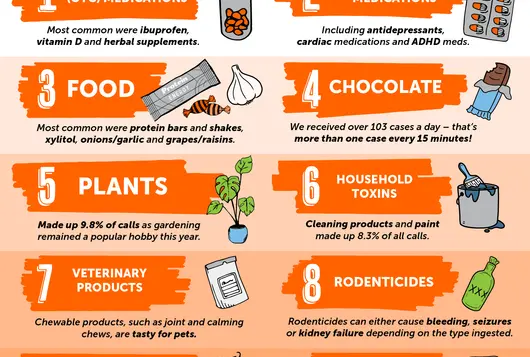Top 10 Pet Toxins of 2023

Download this image below
Each year the ASPCA Animal Poison Control Center (APCC) compiles its call data to examine what types of toxins pets are most exposed to and releases their top 10 categories of potential poisons. In 2023, the APCC received calls about over 351,000 hazardous items. Here are the most common categories starting with the most frequent.
- Over-the-Counter (OTC) Medications
OTC medications remain at number one with 16.8% of the exposures. People sometimes accidentally drop their vitamins and supplements or leave bottles of pain medications (ibuprofen, naproxen) where pets can access them. - Food and Drink
Food and drink remains at number two with 16.2% of the calls. Protein drinks and bars, xylitol gums, grapes/raisins, and onions/garlic make up the largest part of this group. - Human Prescription Medications
Human prescription medications remain in the third spot. Heart medications, inhalers, and ADHD medications are the most commonly ingested. - Chocolate
Chocolate keeps slowly creeping up with 13% of the exposures. These are mostly dogs as cats do not have sweet taste buds and rarely eat enough to cause clinical signs. - Veterinary Products
Veterinary products have moved up two spots with 8.3% of the exposures. Many of these are ingestions of flavored chewable tablets or soft chews. These forms make it easy to administer but really increase the risk of ingestion of the whole container. - Plants and Fungi
Plants and fungi dropped one spot with 8.1% of the exposures. Plants exposures peaked during COVID, when so many of us bought houseplants during quarantine, and have been dropping since then. - Household Products
Household products also dropped one spot with 7.1% of the exposures. Deoxidizers (found in jerky and soft treats) and batteries are common ingestions. Exposure to disinfecting wipes has decreased since COVID. - Rodenticides
Rodenticides remain at number eight with 6.5% of the exposures. Many pets are exposed when rodents move the blocks from safe spaces to spaces that are more accessible to pets. - Insecticides
Insecticides also remain at number nine with 3.5% of the exposures. Reading labels about correct dilution and putting bags away after use can reduce the risks from this category. - Recreational Drugs
Recreational drugs remain in the top 10 with 2.3% of the exposures. While THC exposures continue to rise, the biggest gains were in mushroom (psilocybin and muscarine) exposures.
If you have any reason to suspect your pet has ingested something toxic, please contact your veterinarian or the ASPCA Animal Poison Control Center’s 24-hour hotline at (888) 426-4435.
Downloads
Download AllWe have lots more on this subject:
Topics:
Toxicology & Poison Control
Type:
Job Aid Downloads



